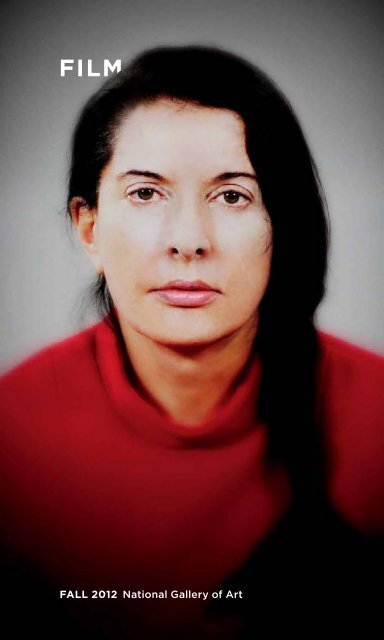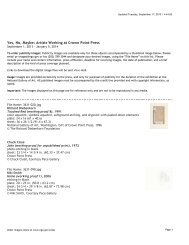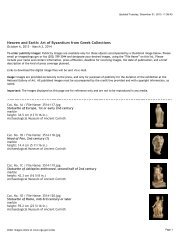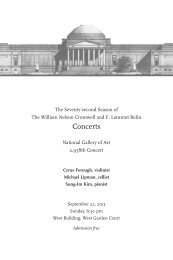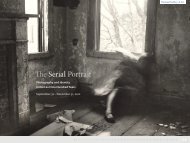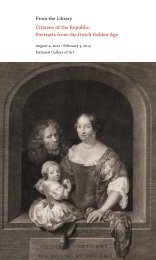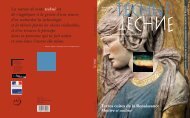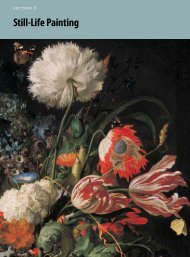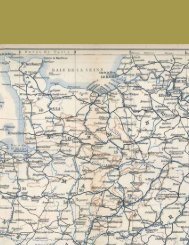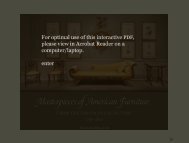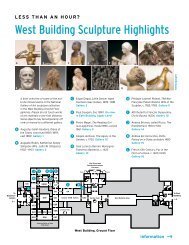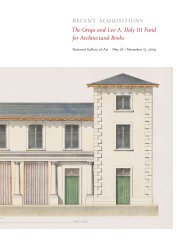Fall Film Calendar - National Gallery of Art
Fall Film Calendar - National Gallery of Art
Fall Film Calendar - National Gallery of Art
Create successful ePaper yourself
Turn your PDF publications into a flip-book with our unique Google optimized e-Paper software.
film<br />
fall 2012 <strong>National</strong> <strong>Gallery</strong> <strong>of</strong> <strong>Art</strong>
Journey to Italy p. 9<br />
cover: Marina Abramović: The <strong>Art</strong>ist Is Present p. 11<br />
9 <strong>Art</strong> <strong>Film</strong>s and Events<br />
16 A Sense <strong>of</strong> Place: František Vláčil<br />
19 Shostakovich and the Cinema<br />
22 Chris Marker: A Tribute<br />
23 From Tinguely to Pipilotti Rist — Swiss <strong>Art</strong>ists on <strong>Film</strong><br />
27 Werner Schroeter in Italy<br />
29 American Originals Now: James Benning<br />
31 On Pier Paolo Pasolini<br />
33 Marcel Carné Revived<br />
<strong>National</strong> <strong>Gallery</strong> <strong>of</strong> <strong>Art</strong>
<strong>Film</strong>s are screened in the <strong>Gallery</strong>’s East Building Auditorium,<br />
Fourth Street and Pennsylvania Avenue NW. Works<br />
are presented in original formats and seating is on a<br />
first-come, first-seated basis. Doors open thirty minutes<br />
before each show and programs are subject to change.<br />
For more information, visit www.nga.gov/programs/film,<br />
e-mail film_department@nga.gov, or call (202) 842-6799.<br />
Photo credits: cover (Marco Anelli © 2010); inside front cover, pp. 8, 18, 34 – 35 (Phot<strong>of</strong>est);<br />
pp. 14 – 15 (<strong>National</strong> <strong>Film</strong> Archive, Prague); p. 4 (George Willeman, Library <strong>of</strong> Congress);<br />
p. 24 (Frenetic <strong>Film</strong>s); p.25 (Bande à Part <strong>Film</strong>s); p. 30 (James Benning); inside back cover<br />
(Ariadne <strong>Film</strong>); back cover (Ediad Productions)<br />
This autumn’s <strong>of</strong>ferings celebrate work by cinematic<br />
pioneers, innovators, and master filmmakers. The ciné-<br />
concert Alice Guy Blaché, Transatlantic Sites <strong>of</strong> Cinéma<br />
Nouveau features films by this groundbreaking direc-<br />
tor, accompanied by new musical scores, presented in<br />
association with a University <strong>of</strong> Maryland symposium.<br />
Other rare screenings include three titles from the 1960s<br />
by Czech filmmaker František Vláčil; feature films made in<br />
Italy by German Werner Schroeter; two programs <strong>of</strong> work<br />
by the late French film essayist Chris Marker; an illustrated<br />
lecture about, a feature by, and a portrait <strong>of</strong> Italian auteur<br />
Pier Paolo Pasolini; a series devoted to the film scores <strong>of</strong><br />
composer Dmitri Shostakovich; highlights from the 2012<br />
International Festival <strong>of</strong> <strong>Film</strong>s on <strong>Art</strong>; and recent docu-<br />
mentaries on a number <strong>of</strong> Switzerland’s notable contemporary<br />
artists. Marcel Carné Revived highlights two <strong>of</strong><br />
the director’s most famous midcentury works <strong>of</strong> poetic<br />
realism, now beautifully restored. Ernie Kovacs: Video <strong>Art</strong><br />
for the Intimate Vacuum contextualizes the experiments<br />
<strong>of</strong> this television pioneer, while two screenings <strong>of</strong> an<br />
interview with Barnett Newman <strong>of</strong>fer a lively perspective<br />
on the painter whose work is currently on display in<br />
the <strong>Gallery</strong>’s Tower. Cultural historian Thomas Elsaesser<br />
presents an illustrated lecture, Germany in the 1920s:<br />
Expanding the <strong>Film</strong> Avant-Garde beyond the Political<br />
Divide. And, toward the end <strong>of</strong> the year, the <strong>Gallery</strong> will<br />
host internationally renowned artist James Benning in the<br />
presentation <strong>of</strong> his most recent recordings, including a<br />
work in progress about two radical Russian art collectives<br />
that are currently in the news.
<strong>Fall</strong>ing Leaves p. 10<br />
7 Sun 2:00 František Vláčil: The Devil’s Trap p. 16<br />
4:30 František Vláčil: Markéta Lazarová p. 17<br />
13 Sat 2:00 František Vláčil: The Valley <strong>of</strong> the Bees p. 17<br />
4:30 Journey to Italy p. 9<br />
14 Sun 4:30 Journey to Italy p. 9<br />
20 Sat 2:30 Shostakovich and the Cinema: King Lear p. 19<br />
21 Sun 4:00 Shostakovich and the Cinema: Hamlet p. 20<br />
27 Sat 2:00 Ciné-Concert: The Patsy p. 9<br />
October<br />
4:00 Ernie Kovacs: Video <strong>Art</strong> for the Intimate Vacuum p. 9<br />
28 Sun 4:30 Shostakovich and the Cinema: Five Days,<br />
Five Nights p. 20
November<br />
3 Sat 3:30 Shostakovich and the Cinema: Testimony p. 21<br />
4 Sun 4:00 Shostakovich and the Cinema: Song <strong>of</strong> the Rivers p. 21<br />
10 Sat 2:00 Ciné-Concert: Alice Guy Blaché, Transatlantic Sites<br />
<strong>of</strong> Cinéma Nouveau p. 10<br />
11 Sun 4:30 Chris Marker Tribute: À bientôt, j’espère; Case <strong>of</strong> the<br />
17 Sat 2:00 Leaving p. 11<br />
Grinning Cat; Cat Listening to Music p. 22<br />
4:00 Marina Abramović: The <strong>Art</strong>ist Is Present p. 11<br />
18 Sun 4:30 Marina Abramović: The <strong>Art</strong>ist Is Present p. 11<br />
23 Fri 1:00 Tinguely p. 23<br />
3:00 Chris Marker Tribute: La Jetée; Sans Soleil p. 23<br />
24 Sat 1:00 Ciné-Concert: Kindred <strong>of</strong> the Dust p. 11<br />
4:00 Werner Schroeter in Italy: Palermo or Wolfsburg p. 28<br />
25 Sun 2:00 Urs Fischer p. 25<br />
4:30 Werner Schroeter in Italy: The Kingdom <strong>of</strong> Naples p. 28<br />
28 Wed 12:30 The Fancy; The Woodmans p. 12<br />
29 Thu 12:30 The Fancy; The Woodmans p. 12<br />
30 Fri 12:30 The Fancy; The Woodmans p. 12<br />
1 Sat 4:30 Max Bill, The Master’s Vision p. 25<br />
December<br />
2 Sun 2:00 Germany in the 1920s: Expanding the Avant-Garde p. 12<br />
7 Fri 12:30 Bon Vent Claude Goretta p. 25<br />
8 Sat 2:30 James Benning: Twenty Cigarettes p. 29<br />
4:30 James Benning: small roads p. 29<br />
9 Sun 4:30 James Benning: the war p. 31<br />
12 Wed 12:30 Bird’s Nest — Herzog and De Meuron in China p. 25<br />
13 Thu 12:30 Barnett Newman p. 13<br />
14 Fri 12:30 International Festival <strong>of</strong> <strong>Film</strong>s on <strong>Art</strong> — I p. 13<br />
15 Sat 12:00 International Festival <strong>of</strong> <strong>Film</strong>s on <strong>Art</strong> — II p. 13<br />
4:00 From Giotto to Pasolini: Narrative in Fresco p. 31<br />
16 Sun 4:30 On Pier Paolo Pasolini: Hawks and Sparrows p. 32<br />
21 Fri 12:30 Barnett Newman p. 13<br />
22 Sat 12:30 Barnett Newman p. 13<br />
2:00 Marcel Carné: Port <strong>of</strong> Shadows (repeats 4:00) p. 33<br />
23 Sun 2:00 Marcel Carné: Children <strong>of</strong> Paradise p. 33<br />
27 Thu 12:30 The Visual Language <strong>of</strong> Herbert Matter p. 27<br />
28 Fri 12:30 The Visual Language <strong>of</strong> Herbert Matter p. 27<br />
29 Sat 12:30 The Color <strong>of</strong> Your Socks — A Year with Pipilotti Rist p. 27<br />
3:30 La Rabbia: The Rage <strong>of</strong> Pasolini p. 32<br />
30 Sun 2:00 Marcel Carné: Children <strong>of</strong> Paradise p. 33
Journey to Italy p. 9<br />
<strong>Art</strong> <strong>Film</strong>s and Events<br />
Oct 13 – Dec 22<br />
JOURNEy TO ITAly<br />
Sat Oct 13, Sun Oct 14 (4:30)<br />
Journey to Italy (Viaggio in Italia, 1954), director Roberto Rossellini’s<br />
modernist breakthrough <strong>of</strong>ten compared to James Joyce’s writ-<br />
ings or Michelangelo Antonioni’s films, has just been restored by<br />
L’Immagine Ritrovata, Bologna, in collaboration with CSC — Cineteca<br />
Nazionale, Rome. Ingrid Bergman and George Sanders, an upperclass<br />
English couple trying to find a buyer for their villa near Naples,<br />
experience new anxieties in their marriage. Evoking the ancient<br />
southern Italian surroundings, Journey to Italy alludes to the power<br />
<strong>of</strong> this timeless place to transform and heal. (Roberto Rossellini, 1954,<br />
DCP, 97 minutes)<br />
CINé-CONCERT: ThE PATSy<br />
Ben Model, piano<br />
Sat Oct 27 (2:00)<br />
Marion Davies, forever linked with the name <strong>of</strong> publishing magnate<br />
William Randolph Hearst, enjoyed a successful career in the silent<br />
cinema. In King Vidor’s The Patsy she plays Patricia Harrington, an<br />
innocent victim in family feuds involving her mother (Marie Dressler)<br />
and sister (Jane Winton), who coyly collects boyfriends. Devising a<br />
plot that employs her talents as a mimic — Mae Murray, Lillian Gish,<br />
and Pola Negri are specialties — she tries to trap a man. (King Vidor,<br />
1928, 35 mm, 78 minutes) A Library <strong>of</strong> Congress restoration.<br />
ERNIE KOVACS: VIDEO ART FOR ThE INTIMATE VACUUM<br />
Bruce Bennett, David Bianculli, Ben Model in person<br />
Sat Oct 27 (4:00)<br />
“Intimate vacuum” was comedian Ernie Kovacs’ tongue-in-cheek definition<br />
<strong>of</strong> television, the medium he broadened in the 1950s with his<br />
9
10 11<br />
absurdist sight gags and pioneering video effects, novel experiments<br />
in network TV’s early years. This program brings together a variety<br />
<strong>of</strong> dada-like sketches, from the silent Eugene Show to the musical<br />
Nairobi Trio to a Dutch Masters commercial in which Kovacs smokes<br />
a cigar under water. The comedian’s love for classical music, fostered<br />
by his wife and collaborator Edie Adams, blossomed on the shows<br />
<strong>of</strong> the late 1950s, and several <strong>of</strong> his “sound into sight” musical pieces<br />
from the ABC specials — early masterworks <strong>of</strong> video art — are also<br />
part <strong>of</strong> this mix. A discussion with three Kovacs historians — Bruce<br />
Bennett, David Bianculli, and Ben Model — follows the screening.<br />
(Total running time approximately 120 minutes)<br />
CINé-CONCERT: AlICE GUy BlAChé, TRANSATlANTIC SITES OF<br />
CINéMA NOUVEAU<br />
Musical accompaniment by Kim and Kathryn Kluge<br />
Sat Nov 10 (2:00)<br />
Alice Guy Blaché (1873 – 1968) is a unique figure in the history <strong>of</strong><br />
cinema — a woman positioned squarely at the front lines <strong>of</strong> international<br />
technological change that first distinguished the cinema as<br />
a form <strong>of</strong> mass entertainment. From production and distribution to<br />
early sound technology and independent direction, she participated<br />
in all aspects <strong>of</strong> the evolving motion picture business. This program<br />
features a selection <strong>of</strong> early films that Guy made in France for<br />
Gaumont, followed by restored single-reel subjects produced by her<br />
American company Solax, and finally a reconstruction <strong>of</strong> one <strong>of</strong> her<br />
three surviving independent features. The original score by composers<br />
Kim and Kathryn Kluge creates a conversation between past and<br />
present. The program is presented in association with the University<br />
<strong>of</strong> Maryland symposium “Alice Guy Blaché: Transatlantic Sites<br />
<strong>of</strong> Cinéma Nouveau, 1896 – 1920.” With special thanks to Caroline<br />
Eades, Elizabeth Papazian, Brian Real, Kim Tomadjoglou, Swedish<br />
<strong>Film</strong> Institute, Embassy <strong>of</strong> France, and Library <strong>of</strong> Congress. <strong>Film</strong>s on<br />
the program include: Alice Guy tourne une phonoscène (1905), early<br />
Gaumont films from the Sieurin Collection (1899 – 1900), Five O’Clock<br />
Tea (1905), Greater Love Hath No Man (1911), Mixed Pets (1911), <strong>Fall</strong>ing<br />
Leaves (1912), The Ocean Waif (1916), and Parson Sue (1912). (Total<br />
running time approximately 100 minutes, followed by discussion)<br />
lEAVING<br />
Sat Nov 17 (2:00)<br />
Václav Havel (1936 – 2011) — poet, playwright, and cherished first<br />
president <strong>of</strong> the Czech Republic — returned to the stage in 2008 with<br />
the new play Leaving (Odcházení). He adapted this absurdist comedy,<br />
in which an ex-government <strong>of</strong>ficial tries to reenter his former life, for<br />
the screen. As the action unfolds on a rural estate, comparisons to<br />
Havel’s own life become clear: “Before the 1989 Revolution, I had an<br />
idea for a character like King Lear, who loses power. It might have<br />
been the influence <strong>of</strong> the generation <strong>of</strong> 1968 — the people who had<br />
been party members . . . after ’68 they were thrown out and started<br />
to live ordinary lives, and they pretended that they didn’t mind, but<br />
in fact they did” — Václav Havel. (2011, Czech with subtitles, DCP,<br />
94 minutes)<br />
MARINA ABRAMOVIć: ThE ARTIST IS PRESENT<br />
Sat Nov 17 (4:00), Sun Nov 18 (4:30)<br />
Over half a million visitors to Marina Abramović’s groundbreaking<br />
2010 Museum <strong>of</strong> Modern <strong>Art</strong> retrospective lined up for hours for the<br />
most alluring aspect <strong>of</strong> this show — a chance to sit opposite Marina at<br />
a table and silently stare, as she stared back. Many were completely<br />
devastated by this rigorous, disquieting, and <strong>of</strong>ten moving experience.<br />
Marina Abramović: The <strong>Art</strong>ist Is Present chronicles not only<br />
the landmark exhibition but the intriguingly evocative career <strong>of</strong> this<br />
Serbia-born, New York – based performance artist, one <strong>of</strong> the most<br />
charismatic public figures <strong>of</strong> our time. (Matthew Akers, 2011, DCP,<br />
106 minutes)<br />
CINé-CONCERT: KINDRED OF ThE DUST<br />
Donald Sosin and Joanna Seaton, piano and voice<br />
Sat Nov 24 (1:00)<br />
Raoul Walsh’s 1922 silent melodrama <strong>of</strong> romantic intrigue in a northwest<br />
logging town, based on a popular novel by the prolific Peter B.<br />
Kyne, features Walsh’s wife, Miriam Cooper, as Nan <strong>of</strong> the Sawdust<br />
Pile, a wronged woman who returns to her hometown to find that her<br />
old sweetheart still loves her but cannot marry her. <strong>Art</strong> direction is by<br />
William Cameron Menzies, who moved on to one <strong>of</strong> the most brilliant<br />
careers in Hollywood production design. Pianist Donald Sosin and
12 13<br />
vocalist Joanna Seaton provide their original musical accompani-<br />
ment. Print courtesy George Eastman House. (Raoul Walsh, 1922,<br />
35 mm, 90 minutes) Preservation funded by The <strong>Film</strong> Foundation.<br />
ThE WOODMANS<br />
preceded by ThE FANCy<br />
Wed Nov 28, Thu Nov 29, Fri Nov 30 (12:30)<br />
The Woodmans investigates the legacy <strong>of</strong> photographer Franc-<br />
esca Woodman as experienced by her parents and older brother,<br />
all <strong>of</strong> whom are successful practicing artists. Not surprisingly, their<br />
perspectives — at once familiar and distanced — rely heavily on the<br />
impressive body <strong>of</strong> provocative work Francesca left before her suicide<br />
at age twenty-two. (C. Scott Willis, 2010, HDCAM, 82 minutes)<br />
The Fancy, completed before the recent spate <strong>of</strong> scholarly interest<br />
in Woodman’s work, is groundbreaking in its approach to its<br />
highly elusive subject. The filmmaker “meticulously sifts physical<br />
evidence and sketchy facts in an attempt to uncover the traces <strong>of</strong><br />
a seemingly suppressed history embedded behind the photographer’s<br />
pictures” — Nicole Armour. (Elizabeth Subrin, 2000, DigiBeta,<br />
36 minutes)<br />
GERMANy IN ThE 1920S: ExPANDING ThE FIlM AVANT-GARDE<br />
BEyOND ThE POlITICAl DIVIDE<br />
Illustrated lecture by Thomas Elsaesser<br />
Sun Dec 2 (2:00)<br />
Cultural historian Thomas Elsaesser, one <strong>of</strong> our most creative and<br />
unconventional thinkers on cinematic culture, film history, and digital<br />
media, speaks on the interconnections between the cinematic avantgardes<br />
<strong>of</strong> the 1920s and modernist architecture, the nonfiction film,<br />
and advertising. Among Elsaesser’s twenty authored and edited<br />
books is an in-depth study <strong>of</strong> German cinema in the 1920s (Weimar<br />
Cinema and After: Germany’s Historical Imaginary), a monograph<br />
on Fritz Lang’s masterpiece Metropolis, and European Cinema: Face<br />
to Face with Hollywood, covering a broad range <strong>of</strong> topics from film<br />
festivals to national cinemas, and from the high-low culture debate<br />
to the cinematic auteurs <strong>of</strong> France, Britain, and Germany. Elsaesser<br />
is presently a senior fellow at the International College <strong>of</strong> Cultural<br />
Technologies and Media Theory in Weimar, Germany. (Approximately<br />
70 minutes) This program is made possible by funds given in memory<br />
<strong>of</strong> Rajiv Vaidya.<br />
INTERNATIONAl FESTIVAl OF FIlMS ON ART — I<br />
Fri Dec 14 (12:30)<br />
The first <strong>of</strong> two events featuring the award-winning works from this<br />
year’s International Festival <strong>of</strong> <strong>Film</strong>s on <strong>Art</strong> — a unique annual event in<br />
Montreal, now in its thirty-first year — includes the Washington premieres<br />
<strong>of</strong> Coloring Light: Brian Clarke (2011, 58 minutes), a portrait <strong>of</strong><br />
the British superstar <strong>of</strong> architectural stained glass; Unfinished Spaces<br />
(2011, 86 minutes), on the remarkable complex <strong>of</strong> Cuban art schools<br />
built by Fidel Castro; and Frédéric Back: Grandeur nature (2011,<br />
78 minutes), on the Canadian artist whose animations are among the<br />
most beloved short works in the world.<br />
INTERNATIONAl FESTIVAl OF FIlMS ON ART — II<br />
Sat Dec 15 (noon)<br />
The second program <strong>of</strong> new films from this year’s acclaimed art film<br />
festival includes Ai Weiwei: Without Fear or Favor (2010, 55 minutes),<br />
BBC Imagine’s recent program on the celebrated Chinese artist;<br />
!W.A.R. Women <strong>Art</strong> Revolution (2011, 82 minutes); and Romain Gary —<br />
Le roman du double (2010, 89 minutes), the story <strong>of</strong> the enigmatic<br />
French author, director, and diplomat who was also the spouse <strong>of</strong><br />
actress Jean Seberg.<br />
BARNETT NEWMAN<br />
Thu Dec 13, Fri Dec 21, Sat Dec 22 (12:30)<br />
A 1960s interview with Barnett Newman from the legendary era <strong>of</strong><br />
<strong>National</strong> Educational Television was originally produced for the NET<br />
series Television USA: <strong>Art</strong>ists. The film is screened in association with<br />
the <strong>National</strong> <strong>Gallery</strong> exhibition In the Tower: Barnett Newman. (Lane<br />
Slate, 1966, 16 mm, 30 minutes)
14 Markéta lazarová p. 17<br />
15
16 17<br />
A Sense <strong>of</strong> Place: František Vláčil<br />
Oct 7 – 13<br />
František Vláčil’s historical pageants summon a far-<strong>of</strong>f<br />
time and place in a naturalistic style suited to his training<br />
in aesthetics and art history. His small body <strong>of</strong> work stands<br />
out from the gritty Czech new wave films <strong>of</strong> the era and, not<br />
surprisingly, was seen as subversive by censors in his native<br />
Czech Republic. Thwarted after the 1968 Soviet invasion,<br />
Vláčil (1924 – 1999) maintained that he was only interested<br />
in “pure film” and applying poetic license to shape allegory<br />
out <strong>of</strong> ancient tales. His work suggests parallels to other<br />
metaphorically rich work <strong>of</strong> the last century including films<br />
by Tarkovsky and Eisenstein. This program encompasses<br />
his best known epics and includes the premiere <strong>of</strong> the new<br />
restoration <strong>of</strong> the medieval Markéta Lazarová. With special<br />
thanks to the Embassy <strong>of</strong> the Czech Republic, the Czech<br />
<strong>National</strong> <strong>Film</strong> Archive, Barbara Karpetová, Mary Fetzko, and<br />
Michal Bregant.<br />
ThE DEVIl’S TRAP<br />
Sun Oct 7 (2:00)<br />
In a drought-stricken Bohemian village, a church inquisitor probes<br />
the local miller to find out if his flourishing grain mill is the work <strong>of</strong><br />
the devil. In this first <strong>of</strong> Vláčil’s three historical-allegorical epics, the<br />
miller’s discovery <strong>of</strong> an underground aquifer has become a source <strong>of</strong><br />
ridicule from villagers. “The opening shot <strong>of</strong> a gnarled effigy <strong>of</strong> Christ<br />
in agony, dwarfing a distant figure on the horizon, neatly establishes<br />
a cruel world where religious authority holds absolute sway and an<br />
innocent miller’s knowledge <strong>of</strong> the land is interpreted as evidence<br />
<strong>of</strong> a diabolical pact” — Michael Brooke. (Ďáblova past, 1962, 35 mm,<br />
Czech with subtitles, 85 minutes)<br />
MARKéTA lAzAROVá<br />
Premiere <strong>of</strong> the restoration<br />
Sun Oct 7 (4:30)<br />
One <strong>of</strong> only a handful <strong>of</strong> filmmakers who has ever tried to recreate<br />
the mood <strong>of</strong> medieval society, Vláčil based Markéta Lazarová on<br />
Vladislav Vančura’s best-selling 1931 novel, in turn based on a story<br />
handed down within Vančura’s family. Sets and costumes were even<br />
made with traditional tools, and actors tried to portray the raw and<br />
unfiltered emotions that presumably prevailed. Heroine Markéta,<br />
raped, kidnapped, and forced to serve an enemy clan, finds refuge<br />
in the orderliness <strong>of</strong> religion. Zdeněk Liška’s haunting musical score<br />
mixes vocal, percussive, and electronic motifs that beautifully buttress<br />
the narrative. This screening represents the American premiere<br />
<strong>of</strong> the latest restoration involving a complicated digital scan at<br />
4K resolution, followed by a painstaking cleanup <strong>of</strong> scratches and<br />
other damage to reinstate as closely as possible the original look <strong>of</strong><br />
the 35 mm film in the form <strong>of</strong> a new digital cinema print. (1967, DCP,<br />
Czech with subtitles, 180 minutes)<br />
ThE VAllEy OF ThE BEES<br />
Sat Oct 13 (2:00)<br />
From another novel by Vančura, The Valley <strong>of</strong> the Bees tells the<br />
odyssey <strong>of</strong> Ondřej, exiled as a child to a strict order <strong>of</strong> religious<br />
knights — his punishment after attempting to sabotage his father’s<br />
wedding. When Ondřej reaches maturity, he returns to his native village<br />
to seek retribution, even as his monk-guardian tries to bait him<br />
back to the order. In bold black-and-white Cinemascope, “Vláčil’s<br />
spectacular orchestration <strong>of</strong> landscape, violent chaos, wild animals,<br />
and medieval iconography is never less than impressive” — Michael<br />
Atkinson. (Údolí včel, 1968, 35 mm, Czech with subtitles, 97 minutes)
18 Hamlet p. 20<br />
19<br />
Shostakovich and the Cinema<br />
Oct 20 – Nov 4<br />
<strong>Film</strong>s featuring scores by Dmitri Shostakovich plus a screening<br />
<strong>of</strong> Tony Palmer’s Testimony are presented in association<br />
with PostClassical Ensemble’s Interpreting Shostakovich<br />
festival. “When talking about Soviet film we must remember<br />
Lenin’s famous statement that ‘<strong>of</strong> all the arts, the most<br />
important for us is the cinema.’ It was Stalin who turned the<br />
dictum into reality . . . . Stalin loved the movies” — Solomon<br />
Volkov. Volkov (author <strong>of</strong> Testimony: The Memoirs <strong>of</strong> Dmitri<br />
Shostakovich) is a participant in the series, along with<br />
filmmaker Tony Palmer, film historian Peter Rollberg, music<br />
historian Roy Guenther, and PostClassical Ensemble’s music<br />
director Angel Gil-Ordóñez and artistic director Joseph<br />
Horowitz.<br />
KING lEAR<br />
Musical prelude with Georgetown University Chamber Singers<br />
Roy Guenther and Peter Rollberg, discussants<br />
Sat Oct 20 (2:30)<br />
Before World War II Russian film director Grigori Kozintsev directed a<br />
stage version <strong>of</strong> King Lear in a Russian translation by Boris Pasternak.<br />
In 1970 he revisited this text to make his film adaptation, shooting on<br />
austere landscapes in Estonia with a cast <strong>of</strong> Baltic actors including<br />
the revered Jüri Järvet in the title role. On the subject <strong>of</strong> Shostakovich’s<br />
music, Kozintsev noted, “I can hear a ferocious hatred <strong>of</strong> cruelty,<br />
the cult <strong>of</strong> power, and the oppression <strong>of</strong> justice . . . a fearless goodness<br />
which has a threatening quality.” (Grigori Kozintsev, 1971, 35 mm,<br />
Russian with subtitles, 139 minutes)
20 21<br />
hAMlET<br />
Musical prelude: Shostakovich Satires, op. 109<br />
Irina Mozyleva, soprano, and Vera Danchenko-Stern, piano<br />
Roy Guenther and Peter Rollberg, discussants<br />
Sun Oct 21 (4:00)<br />
Creatively pruning the text <strong>of</strong> Shakespeare’s play, Russian director<br />
Grigori Kozintsev remains true to the structure, although a number<br />
<strong>of</strong> familiar scenes have been shortened or rendered in visual terms<br />
sans dialogue. “Hamlet has always been filmed in studios but it seems<br />
to me that the key to reincarnating Shakespeare’s words in visual<br />
imagery can only be found in nature . . . . In decisive places, [we must]<br />
oust period stylization <strong>of</strong> the Tudor era and <strong>of</strong> English affectation,<br />
and express the essentials. I have in mind stone, iron, fire, earth, and<br />
sea.” Laurence Olivier proclaimed it the best adaptation ever. (Grigori<br />
Kozintsev, 1964, 35 mm, Russian with subtitles, 140 minutes)<br />
FIVE DAyS, FIVE NIGhTS<br />
North American premiere<br />
Roy Guenther, Tony Palmer, Peter Rollberg, and Solomon Volkov,<br />
discussants<br />
Sun Oct 28 (4:30)<br />
When Red Army captain Lenov arrives in Dresden in May 1945, the<br />
city has been reduced to rubble. Ordered to find hundreds <strong>of</strong> old<br />
master paintings (including Raphael’s Sistine Madonna altarpiece)<br />
that had disappeared from the State <strong>Art</strong> Collection, Lenov succeeds<br />
in locating a hidden cache with the help <strong>of</strong> Dresden residents eager<br />
to rebuild. Several more days and nights will go by, however, before<br />
the remainder <strong>of</strong> the collection is found. The first ever GDR-Soviet<br />
coproduction, Five Days, Five Nights is a rare fictional work about the<br />
wartime looting <strong>of</strong> art. This screening represents the first time the<br />
film has been subtitled in English. Shostakovich composed the score<br />
using parts <strong>of</strong> his String Quartet no. 8. (Fünf Tage, Fünf Nächte, Lew<br />
Arnstam, 1960, 35 mm, German and Russian with subtitles, 100 minutes).<br />
Made possible through the support <strong>of</strong> DEFA — Stiftung, Berlin,<br />
and the DEFA <strong>Film</strong> Library, University <strong>of</strong> Massachusetts Amherst.<br />
TESTIMONy<br />
Roy Guenther, Tony Palmer, Peter Rollberg, and Solomon Volkov,<br />
discussants<br />
Sat Nov 3 (3:30)<br />
Director Tony Palmer’s epic version <strong>of</strong> Solomon Volkov’s edition<br />
<strong>of</strong> Shostakovich’s memoirs is a milestone <strong>of</strong> the biographical film,<br />
in part for the way the music illustrates the life. With Ben Kingsley<br />
as Shostakovich and Terence Rigby as Stalin, the film features the<br />
London Philharmonic conducted by Rudolf Barshai, who in fact knew<br />
Dmitri Shostakovich. Palmer notes, “It is clear to me now that if we<br />
want to know what it was like to live under Stalin in the Soviet Union<br />
from 1924 until 1953, the year <strong>of</strong> Stalin’s death, listen to Shostakovich.<br />
It’s all we’ve got.” (Tony Palmer, 1988, 35 mm, 157 minutes)<br />
SONG OF ThE RIVERS<br />
Roy Guenther, Tony Palmer, Peter Rollberg, and Solomon Volkov,<br />
discussants<br />
Sun Nov 4 (4:00)<br />
Originally produced on behalf <strong>of</strong> the 1953 congress <strong>of</strong> the World<br />
Federation <strong>of</strong> Trade Unions, Song <strong>of</strong> the Rivers is a footage compilation<br />
that became a classic expression <strong>of</strong> the international solidarity<br />
movement. Shot by crews on the Volga, Mississippi, Nile, Yangtze,<br />
Amazon, and Ganges, the workers’ destinies are united by these<br />
rivers coursing through their native lands. At the East German DEFA<br />
Stiftung studio in Berlin, the editing was supervised by Joris Ivens<br />
and then distributed in twenty-eight languages. The project brought<br />
together many artists including Shostakovich, Bertolt Brecht, and<br />
Paul Robeson, as well as Ivens and the other filmmakers. (Das Lied<br />
der Ströme, Joris Ivens and others, 1954, 35 mm, subtitles, 103 minutes)<br />
Made possible through the support <strong>of</strong> DEFA — Stiftung, Berlin,<br />
and the DEFA <strong>Film</strong> Library, University <strong>of</strong> Massachusetts Amherst.
22 23<br />
Chris Marker: A Tribute<br />
Nov 11 – 23<br />
An homage in two parts to the late French filmmaker Chris<br />
Marker (1921 – 2012) recalls his oeuvre through recurring<br />
motifs — the mysterious workings <strong>of</strong> memory and <strong>of</strong> politics,<br />
and his avowed fascination for cats. Marker refined the<br />
genre now known as the essay film — a reflective montage<br />
<strong>of</strong> images, ideas, and narrative that goes beyond traditional<br />
form to unfold a poetic theme. “We do not remember, we<br />
rewrite memory, much as history is rewritten.”<br />
À BIENTôT, J’ESPèRE<br />
followed by CASE OF ThE GRINNING CAT<br />
and CAT lISTENING TO MUSIC<br />
Sun Nov 11 (4:30)<br />
À bientôt, j’espère immerses the viewer in a 1960s-style protest<br />
through dialogue with workers in the midst <strong>of</strong> a strike at a textile<br />
plant in the city <strong>of</strong> Besançon. The working class, they believe, is at<br />
the mercy <strong>of</strong> a system dedicated to keeping them powerless. Though<br />
they achieved very few gains, these strikers helped lay the groundwork<br />
for the revolutionary protests <strong>of</strong> May 1968. (1968, DigiBeta,<br />
French with subtitles, 39 minutes)<br />
In Case <strong>of</strong> the Grinning Cat, Marker illustrates a more recent sort<br />
<strong>of</strong> political consciousness by investigating a wave <strong>of</strong> graffiti murals<br />
around Paris — drawings <strong>of</strong> an oddly toothy cat. These graffiti first<br />
appeared following September 11, 2001, and continued through a<br />
period <strong>of</strong> mounting international discontent. Thoughts about the<br />
purpose <strong>of</strong> public protest and the state <strong>of</strong> international politics<br />
are juxtaposed with ruminations on art. “La poésie est dans la rue”<br />
(Poetry is in the street) — Chris Marker. (2004, DigiBeta, French with<br />
subtitles, 58 minutes)<br />
The program closes with the reclusive Guillaume-en-Egypte,<br />
Marker’s beloved pet cat and alter ego, enjoying the mellow rhythms<br />
<strong>of</strong> a piano sonata by Federico Mompou. (1990, DigiBeta, 3 minutes)<br />
SANS SOlEIl<br />
preceded by lA JETéE<br />
Fri Nov 23 (3:00)<br />
In Sans Soleil Marker uses modern Japan, “with its electronic games,<br />
its age-old obsessions and atomic bomb memories, as a gameboard<br />
for a system <strong>of</strong> references connecting such diverse subjects as the<br />
poverty <strong>of</strong> Africa, the open spaces <strong>of</strong> Iceland, and the vertigo <strong>of</strong><br />
memory as perceived by Hitchcock in San Francisco. He explores<br />
memory as an alternate reality; his Japan is one <strong>of</strong> captured movements<br />
and absurd moments, <strong>of</strong> rituals and inadvertent theatrics. . . .<br />
what was memory becomes fiction” — Judy Bloch. (1982, 35 mm,<br />
English and French with subtitles , 100 minutes)<br />
In La Jetée, Marker’s half-hour futuristic photonovel about the<br />
power <strong>of</strong> memory, a prisoner is haunted by a photographic image<br />
from the past. The man is promised a chance to rediscover the meaning<br />
<strong>of</strong> this image, as a participant in a time travel experiment. (1962,<br />
35 mm, English, French, and German with subtitles, 29 minutes)<br />
From Tinguely to Pipilotti Rist — Swiss <strong>Art</strong>ists on <strong>Film</strong><br />
Nov 23 – Dec 29<br />
A series <strong>of</strong> new documentary works by Swiss filmmakers on<br />
the country’s contemporary artists is presented in association<br />
with the Embassy <strong>of</strong> Switzerland.<br />
TINGUEly<br />
Fri Nov 23 (1:00)<br />
Jean Tinguely cast a spell with his kinetic sculptures and moving<br />
machines — the self-destroying Homage to New York (1960) was one<br />
<strong>of</strong> the most celebrated. Twenty years after his death the bande à
24 Tinguely p. 23<br />
25<br />
Jean — old friends and acquaintances — recalls the life and personality<br />
<strong>of</strong> this revolutionary artist, who was as daring in his private life as he<br />
was in his work. (Thomas Thümena, 2011, 35 mm, German and French<br />
with subtitles, 87 minutes)<br />
URS FISChER<br />
Sun Nov 25 (2:00)<br />
Writing in The New Yorker, Calvin Tomkins noted that “Urs Fischer’s<br />
art, like Fischer himself, is highly memorable but hard to pin down.”<br />
His Bread House is a case in point — a life-size alpine chalet constructed<br />
entirely from loaves <strong>of</strong> bread in different sizes and shapes.<br />
As filmmaker Schumacher notes, “he combines a pop immediacy with<br />
a neo-baroque taste for the absurd.” (Iwan Schumacher, 2010, DCP,<br />
Swiss-German and Italian with subtitles, 98 minutes)<br />
MAx BIll, ThE MASTER’S VISION<br />
Sat Dec 1 (4:30)<br />
One <strong>of</strong> the most influential designers <strong>of</strong> the last century was Max Bill<br />
(1908 – 1994). Studying at the Bauhaus under Albers, Kandinsky, Klee,<br />
and Schlemmer, he relied on mathematical precision and “creating<br />
rhythm in an enclosed shape.” Conceiving everything from watches<br />
to typography, Max Bill was also an ardent antifascist with a social<br />
awareness and early environmental concern. (Erich Schmid, 2008,<br />
35 mm, German with subtitles, 94 minutes)<br />
BON VENT ClAUDE GORETTA<br />
Fri Dec 7 (12:30)<br />
<strong>Film</strong>maker Lionel Baier travels to Geneva to interview his spiritual<br />
mentor, Claude Goretta, one <strong>of</strong> the most successful Swiss movie<br />
directors <strong>of</strong> all time, to learn a few new tricks. During the encounter,<br />
which also included Isabelle Huppert (Goretta directed the actress in<br />
her first major role), Nathalie Baye, Frédérique Meininger, and Michel<br />
Robin, Goretta opens up about his life and his methods. (Lionel Baier,<br />
2011, DigiBeta, French with subtitles, 58 minutes)<br />
BIRD’S NEST — hERzOG AND DE MEURON IN ChINA<br />
Wed Dec 12 (12:30)<br />
The <strong>National</strong> Stadium in Beijing (“Bird’s Nest”), built for the 2008<br />
summer Olympics, was a complicated venture helmed by the Basel
26 Bon Vent Claude Goretta p. 25<br />
27<br />
firm <strong>of</strong> Jacques Herzog and Pierre de Meuron. Joined by artist Ai<br />
Weiwei and others, the team came up with their master plan by care-<br />
fully studying traditional Chinese forms, an interesting opportunity to<br />
build bridges between two cultures. (Christoph Schaub and Michael<br />
Schindhelm, 2008, DigiBeta, 87 minutes)<br />
ThE VISUAl lANGUAGE OF hERBERT MATTER<br />
Thu Dec 27, Fri Dec 28 (12:30)<br />
With the help <strong>of</strong> historical footage and films shot by Swiss-American<br />
artist Herbert Matter (1907 – 1984) himself, this feature documen-<br />
tary portrays the career <strong>of</strong> an almost forgotten creative genius who<br />
contributed a vast expertise to the evolution <strong>of</strong> twentieth-century<br />
graphic design, typography, and their related fields, such as advertis-<br />
ing. (Reto Caduff, 2011, DigiBeta, German with subtitles, 86 minutes)<br />
ThE COlOR OF yOUR SOCKS — A yEAR WITh PIPIlOTTI RIST<br />
Sat Dec 29 (12:30)<br />
Renowned Swiss video artist Pipilotti Rist — known for her colorful,<br />
cheery, and earthy work about gender and the human body — is seen<br />
here in her Zurich studio as well as at a Museum <strong>of</strong> Modern <strong>Art</strong> exhibition.<br />
For the first time, she has permitted a documentary filmmaker<br />
to record her creative process. (Michael Hegglin, 2009, DigiBeta,<br />
German with subtitles, 52 minutes)<br />
Werner Schroeter in Italy<br />
Nov 24 and 25<br />
Opera, theater, and film director Werner Schroeter (1945 –<br />
2010) resists easy classification. Linked with the new German<br />
cinema — the rebellious group <strong>of</strong> directors who hoped to<br />
revitalize postwar film culture — Schroeter’s edgy romanticism<br />
and fondness for high camp kept him on the margins.<br />
He worked with an extraordinary range <strong>of</strong> actors (Isabelle<br />
Huppert, Bulle Ogier, Carole Bouquet, and Magdalena
28 29<br />
Montezuma, his muse.) “What Schroeter does with a face, a<br />
cheekbone, lips, the expression <strong>of</strong> the eyes . . . is a multiplying<br />
and burgeoning <strong>of</strong> the body, an exultation” — Michel Foucault.<br />
These two early features reveal a deep affection for the<br />
south <strong>of</strong> Italy — Schroeter had once been a student in Naples<br />
and knew the region’s lore. With thanks to the Munich <strong>Film</strong><br />
Museum and the Goethe-Institut in Washington.<br />
PAlERMO OR WOlFSBURG<br />
Sat Nov 24 (4:00)<br />
Young Nicola leaves his home in Sicily to seek a fortune in the indus-<br />
trial north, finding employment at a Volkswagen plant in Wolfsburg,<br />
Germany, “a land without light, without sun, without song.” Humili-<br />
ation and isolation eventually drive him to settle some scores in this<br />
far-<strong>of</strong>f and stressful place, culminating in the film’s surreal final act.<br />
One <strong>of</strong> the best <strong>of</strong> the New German Cinema films to depict complex<br />
cultural differences through tales <strong>of</strong> the guest worker (Gastarbeiter),<br />
Palermo oder Wolfsburg was awarded the Golden Bear at the Berli-<br />
nale. “The Passion <strong>of</strong> the Sicilian migrant in the holy land <strong>of</strong> capital-<br />
ism” — Olaf Moller. (Werner Schroeter, 1980, DigiBeta, Italian and<br />
German with subtitles, 175 minutes)<br />
ThE KINGDOM OF NAPlES<br />
Introduction by Roy Grundman<br />
Sun Nov 25 (4:30)<br />
Schroeter took to the streets <strong>of</strong> Naples to make this unusual chronicle<br />
<strong>of</strong> a poor family, tracing the lives <strong>of</strong> brother and sister Massimo and<br />
Vittoria from the 1940s through the 1970s, while painting a broad<br />
context both political and cultural (even reenacting the historic<br />
1964 departure <strong>of</strong> Michelangelo’s Pietà from the port <strong>of</strong> Naples as it<br />
headed to New York for the World’s Fair). “Impassioned, bemused,<br />
even at times hallucinatory . . . . Friends and acquaintances in Italy<br />
joined in the project, to such an extent that this could be called more<br />
an Italian film for Italians than a German one shot in Italy . . . ” — Kevin<br />
Thomas. (Il Regno di Napoli, 1978, DigiBeta, Italian with subtitles,<br />
125 minutes)<br />
American Originals Now: James Benning<br />
Dec 8 and 9<br />
Renowned artist and faculty member at the California Institute<br />
<strong>of</strong> the <strong>Art</strong>s, James Benning has been lauded as a structural<br />
filmmaker though his work is grounded in a variety <strong>of</strong><br />
film practices. For more than four decades, he has influenced<br />
the international avant-garde. Known for composed long<br />
takes with an acute sensitivity to out-<strong>of</strong>-frame sound, Benning’s<br />
films (and now high-definition recordings) are intense<br />
studies <strong>of</strong> places, travels, landscapes, and more recently,<br />
individuals. These three programs are presented in association<br />
with the photography exhibition The Serial Portrait:<br />
Photography and Identity in the Last One Hundred Years.<br />
TWENTy CIGARETTES<br />
Sat Dec 8 (2:30)<br />
<strong>Film</strong> stock and tobacco usage are both purported to be in decline,<br />
seen as cultural remnants only dabbled in by diehards. While recording<br />
with cutting-edge digital technology, Benning uses the duration<br />
<strong>of</strong> a lit cigarette as the framing device for each subject in this series<br />
<strong>of</strong> portraits. One pack, twenty people: each intimately framed and<br />
alone with the camera in as long as it takes to smoke just one. (2011,<br />
HD, 99 minutes)<br />
SMAll ROADS<br />
James Benning in person<br />
Sat Dec 8 (4:30)<br />
Forty-seven shots <strong>of</strong> roads crisscrossing the United States from the<br />
Pacific coast to the Midwest: a film best described, according to Benning,<br />
“by making a list <strong>of</strong> the roads in question and the cars that drive<br />
on them.” An excerpted list <strong>of</strong> shots 11 through 14: “11. CA Hwy 178: no
30 Twenty Cigarettes p. 29<br />
small roads p. 29<br />
31<br />
vehicles. 12. Badwater Rd: 2004 Chevrolet Tahoe, black; 2001 Toyota<br />
Sequoia, green. 13. Arizona Hwy 85: 2003 Ford F350 pickup, black;<br />
2009 Lincoln MKX, black; 2008 and 2009 Ford F150 (Border Patrol)<br />
pickups, white. 14. White Sands Rte 10: 2008 Toyota Tundra pickup,<br />
black.” (2011, HDCAM, 103 minutes)<br />
ThE WAR<br />
Work in progress<br />
James Benning in person<br />
Sun Dec 9 (4:30)<br />
Benning’s most recent work utilizes YouTube footage from the radical<br />
Russian art collectives Voina (War) and Pussy Riot, both recently<br />
involved in legal struggles with the Russian government. (2012,<br />
HDCAM, approximately 60 minutes)<br />
On Pier Paolo Pasolini<br />
Dec 15 – 29<br />
Pier Paolo Pasolini (1922 – 1975) — radical poet, philosopher,<br />
painter, intellectual, novelist, and filmmaker — would have<br />
been ninety years old this year. Controversial during his<br />
lifetime for his dissident views on Italian politics and contemporary<br />
culture, he is now recognized as a visionary, a creative<br />
thinker whose writings continue to influence European writers,<br />
politicians, and intellectuals. This three-part program<br />
considers his contributions from distinct points <strong>of</strong> view.<br />
FROM GIOTTO TO PASOlINI: NARRATIVE IN FRESCO AND FIlM<br />
Illustrated discussion by David Gariff<br />
Sat Dec 15 (4:00)<br />
<strong>Art</strong> historian and lecturer David Gariff discusses the life and career<br />
<strong>of</strong> Pier Paolo Pasolini focusing on his use <strong>of</strong> Italian medieval and<br />
Renaissance painting. “What I see in my mind,” said Pasolini, “are the
32 33<br />
frescoes <strong>of</strong> Giotto and Masaccio. I cannot conceive any [film] image,<br />
landscape, or composition outside the fourteenth century.” (Approxi-<br />
mately 50 minutes)<br />
hAWKS AND SPARROWS<br />
Sun Dec 16 (4:30)<br />
Pasolini’s alleged favorite among his works is this madcap fable fea-<br />
turing the incomparable “prince <strong>of</strong> laughter” Totò, young comic actor<br />
Ninetto Davoli, and an <strong>of</strong>ficious talking crow who recites a tale <strong>of</strong><br />
two friars (also Totò and Ninetto) asked by Saint Francis to preach a<br />
doctrine <strong>of</strong> love to the overbearing hawks and lowly sparrows <strong>of</strong> the<br />
field. The three travelers ramble around the countryside, seeing only<br />
a defiled and dreary landscape, abused by the greed <strong>of</strong> industrial<br />
society. Ennio Morricone’s score features the great singer-songwriter<br />
Domenico Modugno (Volare) vocalizing the opening credits in a teas-<br />
ingly self-mocking style. (Uccellacci e uccellini, 1966, 35 mm, Italian<br />
with subtitles, 86 minutes) Print courtesy Harvard <strong>Film</strong> Archive.<br />
lA RABBIA: ThE RAGE OF PASOlINI<br />
Washington premiere<br />
Sat Dec 29 (3:30)<br />
This 1963 feature essay — a collagelike compilation <strong>of</strong> moments<br />
caught on newsreels, including the revolution in Cuba, workers at a<br />
Fiat plant, floods in Europe, even the death <strong>of</strong> Marilyn Monroe — was<br />
stripped <strong>of</strong> its radical undertone when producer Gastone Ferrante<br />
added a section featuring conservative ideologue Giovanni Guares-<br />
chi. In 2008, forty-five years after its release (and thirty years after<br />
the filmmaker’s death), Giuseppe Bertolucci recaptured his friend’s<br />
original purpose by reconstructing a new version from Pasolini’s<br />
notes and original dialogue transcript. (1963 – 2008, 35 mm, Italian<br />
with subtitles, 84 minutes) Restoration from Fondazione Cineteca<br />
di Bologna.<br />
Marcel Carné Revived<br />
Dec 22 – 30<br />
Two <strong>of</strong> Marcel Carné’s most famous works <strong>of</strong> poetic realism<br />
have been rereleased in bright new digital cinema prints. With<br />
special thanks to Rialto Pictures and Janus <strong>Film</strong> Collection.<br />
PORT OF ShADOWS<br />
Sat Dec 22 (2:00 and 4:00)<br />
In the first <strong>of</strong> two new restorations <strong>of</strong> classic works by Carné — for<br />
both projects, Carné was joined by writer Jacques Prévert and<br />
production designer Alexandre Trauner — a waterfront café in the<br />
lower depths <strong>of</strong> Le Havre becomes a shadowy backdrop for criminal<br />
low-lifes and ill-fated love. Despairing army defector Jean Gabin,<br />
hiding from authorities, falls for the restless beauty Michèle Morgan<br />
while waiting to get out <strong>of</strong> town. Maurice Jaubert’s score and Eugen<br />
Schüfftan’s camera work reinforce the menace below the murky<br />
surface in this prime example <strong>of</strong> French poetic realism. (Le quai des<br />
brumes, 1938, DCP, French with subtitles, 91 minutes)<br />
ChIlDREN OF PARADISE<br />
Sun Dec 23, Sun Dec 30 (2:00)<br />
A celebration <strong>of</strong> theatrical life on the famous Boulevard du<br />
Crime — once the site <strong>of</strong> small playhouses (including Théâtre des<br />
Funambules) where Parisians strolled nightly, until the city was rebuilt<br />
in the 1860s — the tale unfolds around a romantic rivalry for the love<br />
<strong>of</strong> Garance (Arletty), adored courtesan <strong>of</strong> the boulevard. Several<br />
characters are based on historical figures, including the Bohemian-<br />
French mime Jean-Gaspard Deburau known as Baptiste (Jean-Louis<br />
Barrault). Marred for many years by poor or incomplete commercial<br />
prints, Les enfants du paradis has been digitally restored to its<br />
full black-and-white brilliance. (1945, DCP, French with subtitles,<br />
163 minutes)
34 Children <strong>of</strong> Paradise p. 33<br />
35
36 3<br />
Index<br />
À bientôt, j’espère 22<br />
Barnett Newman 13<br />
Bird’s Nest — Herzog and De Meuron<br />
in China 25<br />
Bon Vent Claude Goretta 25<br />
Case <strong>of</strong> the Grinning Cat 22<br />
Cat Listening to Music 22<br />
Children <strong>of</strong> Paradise 33<br />
Ciné-Concert: Alice Guy Blaché,<br />
Transatlantic Sites <strong>of</strong> Cinéma<br />
Nouveau 10<br />
Ciné-Concert: Kindred <strong>of</strong> the Dust 11<br />
Ciné-Concert: The Patsy 9<br />
Color <strong>of</strong> Your Socks — A Year with<br />
Pipilotti Rist, The 27<br />
Devil’s Trap, The 16<br />
Ernie Kovacs: Video <strong>Art</strong> for the<br />
Intimate Vacuum 9<br />
Fancy, The 12<br />
Five Days, Five Nights 20<br />
From Giotto to Pasolini: Narrative in<br />
Fresco and <strong>Film</strong> 31<br />
Germany in the 1920s: Expanding the<br />
<strong>Film</strong> Avant-Garde 12<br />
Hamlet 20<br />
Hawks and Sparrows 32<br />
International Festival <strong>of</strong> <strong>Film</strong>s on<br />
<strong>Art</strong> — I 13<br />
International Festival <strong>of</strong> <strong>Film</strong>s on<br />
<strong>Art</strong> — II 13<br />
Journey to Italy 9<br />
Kingdom <strong>of</strong> Naples, The 28<br />
King Lear 19<br />
La Jetée 23<br />
La Rabbia: The Rage <strong>of</strong> Pasolini 32<br />
Leaving 11<br />
Marina Abramović: The <strong>Art</strong>ist Is<br />
Present 11<br />
Markéta Lazarová 17<br />
Max Bill, The Master’s Vision 25<br />
Palermo or Wolfsburg 28<br />
Port <strong>of</strong> Shadows 33<br />
Sans Soleil 23<br />
small roads 29<br />
Song <strong>of</strong> the Rivers 21<br />
Testimony 21<br />
Tinguely 23<br />
Twenty Cigarettes 29<br />
Urs Fischer 25<br />
Valley <strong>of</strong> the Bees, The 17<br />
Visual Language <strong>of</strong> Herbert Matter,<br />
The 27<br />
war, the 31<br />
The Woodmans 12<br />
Max Bill, The Master’s Vision p. 25<br />
back cover: Ernie Kovachs: Video <strong>Art</strong> for the Intimate Vacuum p. 25


